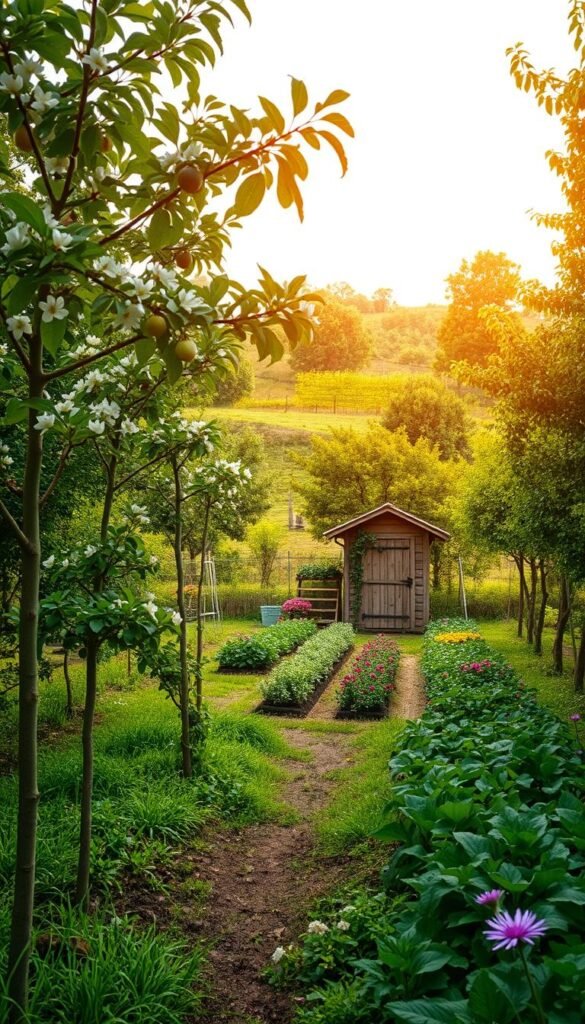Imagine stepping outside to pluck sun-warmed treats from branches you nurtured. More Americans than ever are discovering this joy, with homegrown edibles offering healthier snacks, lower grocery bills, and eco-friendly satisfaction. But turning that dream into reality requires smart planning from day one.
This hands-on resource simplifies the journey for newcomers and seasoned growers alike. You’ll learn how to match plants to your local weather patterns and yard conditions – crucial steps many overlook. Soil quality checks, spacing tricks for small areas, and watering routines become clear through practical examples.
While young saplings demand attention early on, your efforts multiply over seasons. We’ll show you maintenance shortcuts that prevent common pitfalls, like poor pollination or pest invasions. Whether craving crisp apples or juicy peaches, our methods adapt to various climates across the U.S.
Patience pays off when that first harvest arrives. With proper care, your green investment grows into a legacy – producing annual rewards while boosting property value. Let’s dig into the essentials that transform sparse patches into thriving food sources.
Getting Started with Your Fruit Tree Garden
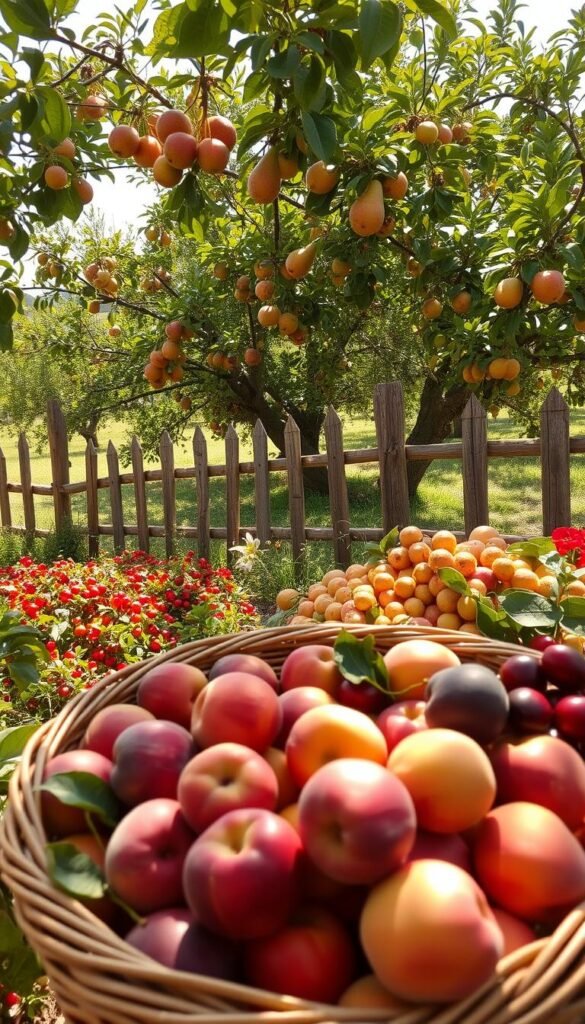
Picture this: sweet rewards hanging within arm’s reach, grown through your own care. Cultivating edibles at home brings triple wins – thinner wallets stay fuller, meals gain nutrition boosts, and nature gets a helping hand. Let’s explore how to begin this flavorful journey.
Why Bite into Backyard Cultivation?
Store-bought snacks can’t match what grows in your yard. Consider these eye-openers:
| Supermarket Finds | Homegrown Goodness | |
|---|---|---|
| Cost per pound | $2.50-$4.00 | $0.50-$1.00* |
| Nutrient retention | 40-60% | 95-100% |
| Chemical exposure | High | None |
“That first juicy peach from your sapling? Pure magic,” says home grower Marissa T. from Oregon. “Tastes like victory.”
Laying the Groundwork
Success starts before digging holes. Follow this roadmap:
- Test sunlight patterns – most edibles need 6+ daily hours
- Measure available space (dwarf varieties fit patios)
- Check local frost dates using USDA zone maps
New to cultivation? Start with apple or pear varieties – they handle beginner mistakes gracefully. Remember, saplings need 2-4 seasons to fruit, but delayed gratification makes harvests sweeter.
Understanding Your Landscape and Soil
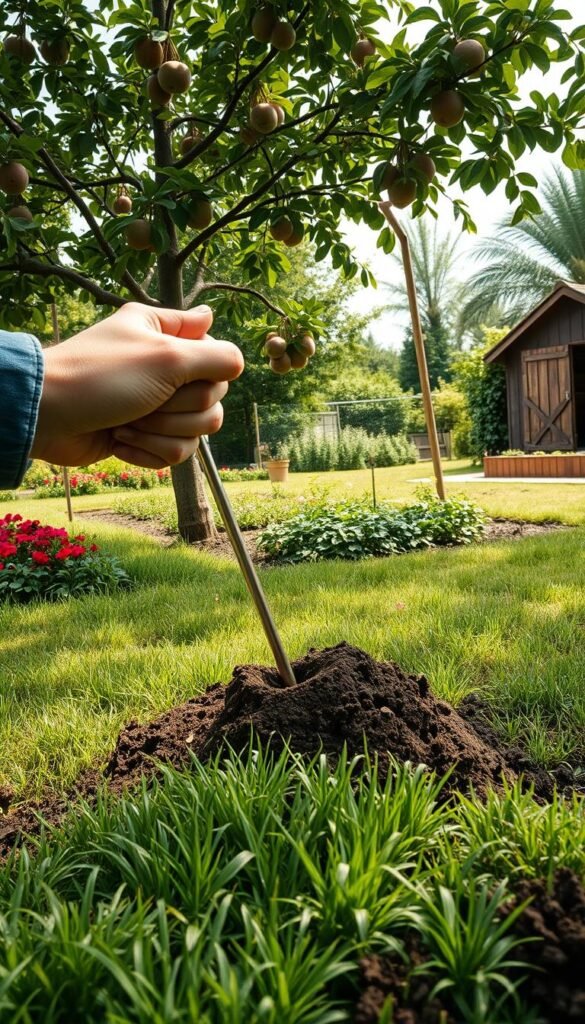
Your backyard’s hidden features determine whether saplings flourish or struggle. What lies beneath the surface and unique pockets of warmth in your space directly impact plant health. Let’s explore how to read these natural clues.
Dirt Detective Work
Start with a mason jar test: fill it halfway with soil, add water, shake, and let settle overnight. Layers will show sand, silt, and clay ratios. This DIY method reveals what your earth needs:
| Soil Type | Common Issue | Quick Fix |
|---|---|---|
| Clay-heavy | Poor drainage | Mix in 3″ compost |
| Sandy | Dries too fast | Add clay + organic matter |
| Balanced | pH imbalance | Apply sulfur or lime |
Most edible plants thrive in slightly acidic earth (6.0-7.0 pH). Local extension offices offer $15-30 professional tests that pinpoint nutrient gaps. “My report showed crazy low potassium,” shares California grower Luis R. “Fixed it with banana peels buried near roots.”
Heat Zones Matter
Walk your property at different times. Notice where morning frost melts first or afternoon shade lingers. These microclimates let you push growing limits:
- South-facing walls radiate warmth
- Paved areas store daytime heat
- Low spots collect cold air
A protected corner near your garage might support citrus in zone 6. Conversely, avoid planting early bloomers where cold pools. Smart placement means happier plants and bigger harvests.
Choosing the Right Fruit Trees for Your Garden
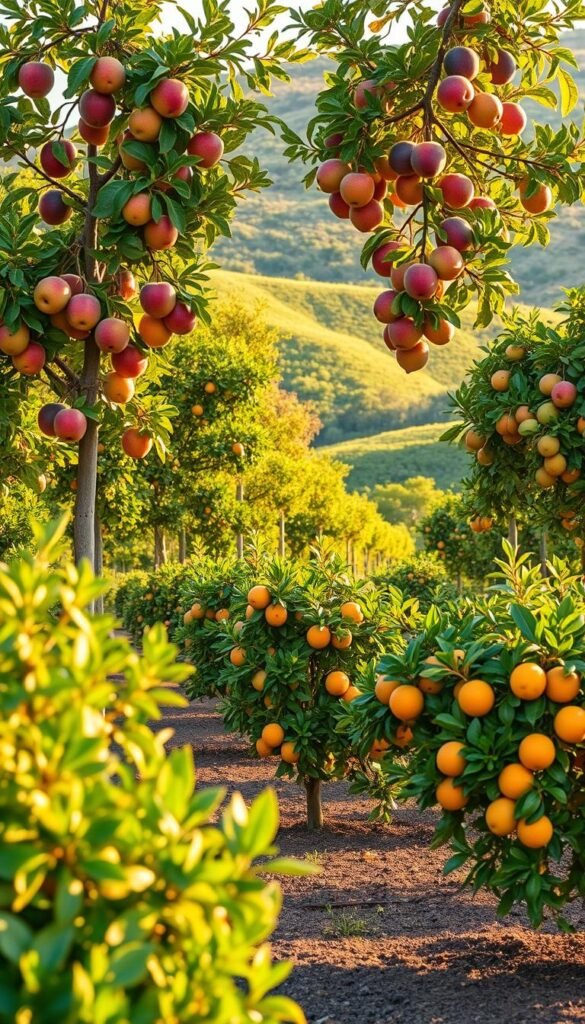
Selecting the perfect additions to your edible landscape requires more than just picking what looks good at the nursery. Climate compatibility determines whether your saplings become thriving producers or constant headaches. While USDA zones provide temperature guidelines, they don’t reveal the full story.
Matching Varieties with Your Climate
Start by checking your USDA zone through the online map tool. But remember – this number only shows average winter lows. True success comes from understanding three hidden factors:
- Moisture patterns: Citrus trees crave regular water, while figs thrive in drier soils
- Chill hours: Apples need 500-1,000 cold hours below 45°F to set buds
- Heat tolerance: Avocados scorch in desert climates but flourish near coasts
Compare local conditions to variety requirements using this quick guide:
| Type | Ideal Conditions | Best For |
|---|---|---|
| Olives | Dry summers, mild winters | Mediterranean climates |
| Persimmons | Humid summers, cold snaps | Eastern states |
| Pomegranates | Hot days, cool nights | Southwest regions |
Visit nearby growers for proven winners. “My neighbor’s loaded plum tree convinced me to plant the same type,” shares Texas gardener Clara B. “Three years later, I’m swapping jams with her!”
Prioritize disease-resistant options like ‘Liberty’ apples or ‘Brown Turkey’ figs. These handle regional pests better, giving you more fruit and fewer sprays. Always match selections to your family’s snacking habits – no sense growing quince if everyone loves peaches!
Fruit Tree Garden 101: Choosing, Planting, and Maintaining Healthy Trees
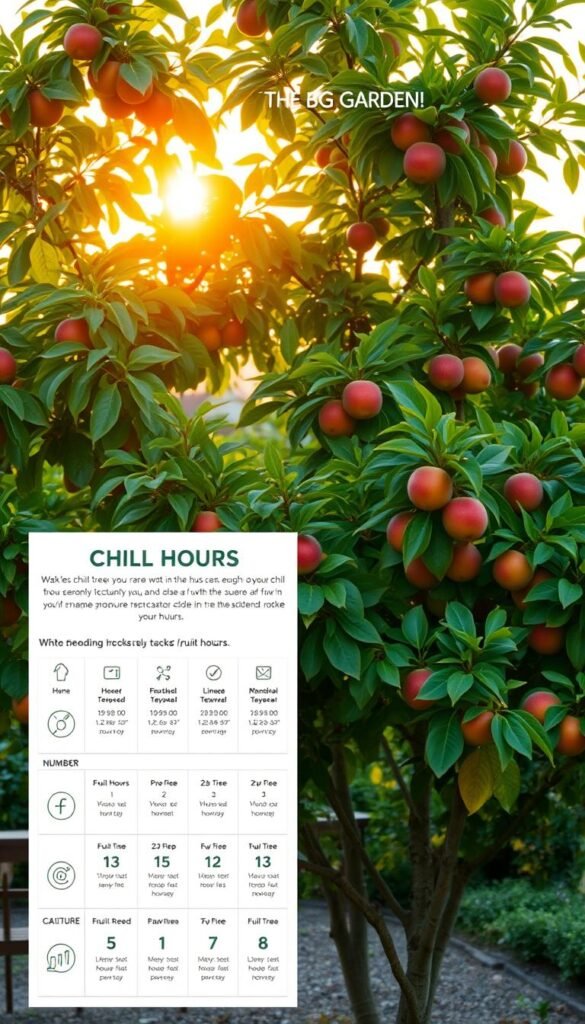
Winter’s secret code for abundant harvests lies in understanding your area’s cold patterns. While sunlight and soil get most attention, chill hours quietly determine whether your plants will burst with flavor or leave you empty-handed come harvest time.
Cracking the Cold Code
Chill hours count consecutive winter periods (34°-45°F) when plants reset their biological clocks. Without this dormancy break, many varieties struggle to flower properly. Here’s what different types need:
| Variety | Required Chill Hours | Best Regions |
|---|---|---|
| Peaches | 200-800 | Mid-Atlantic, Midwest |
| Citrus | 0-100 | Southwest, Florida |
| Cherries | 400-1,000 | Pacific Northwest |
| Figs | 100-200 | Southern states |
Warmer zones aren’t doomed! Breeders developed low-chill options like ‘Anna’ apples (200 hours) for California or ‘Sunhome’ nectarines (150 hours) for Texas. Track local patterns using apps like Chill Tracker or your state’s agricultural extension website.
“I thought my Meyer lemon was broken,” laughs Arizona grower Tina K. “Turns out our 80 chill hours were perfect – it just needed more time to mature.” Most plants need 2-3 years before hitting their stride.
For detailed guidance on selecting climate-appropriate varieties, explore our region-specific growing guides. Remember: matching cold requirements to your microclimate ensures yearly rewards without constant guesswork.
Planning Your Orchard Layout and Tree Spacing
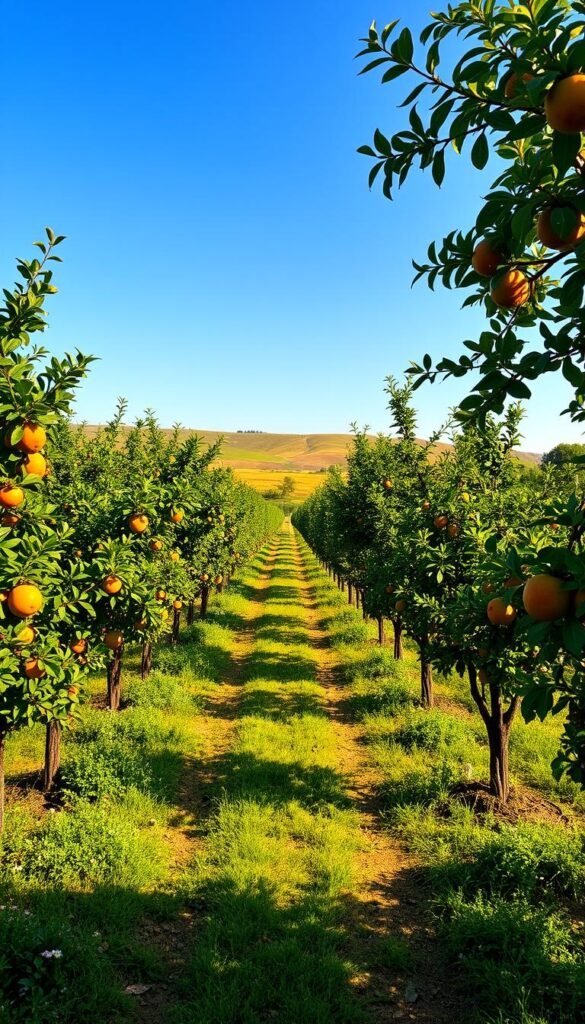
Strategic placement transforms saplings into productive partners. Like arranging furniture in a sunlit room, your edible landscape needs breathing space to flourish. Crowded plants become stressed plants – inviting trouble while reducing yields.
Optimal Tree Spacing for Air Circulation
Airflow acts as nature’s disinfectant. Follow this formula for healthy spacing:
- Measure mature canopy width (check nursery tags)
- Divide by two for minimum trunk-to-trunk distance
- Add 18-24″ between dwarf varieties
A 10-foot-wide apple specimen needs 5 feet of clearance on all sides. This buffer prevents overlapping branches that trap moisture – prime conditions for powdery mildew and aphids.
Avoiding Crowding for Maximum Yield
Competition starves roots and shades fruit buds. Use these space-saving solutions:
| Tree Type | Ideal Spacing | Space Hack |
|---|---|---|
| Dwarf | 6-8 ft | Espalier along fences |
| Semi-dwarf | 12-15 ft | Interplant with berries |
| Standard | 18-25 ft | Use as shade trees |
Multi-grafted options let you grow four apple types in one footprint. “My combo tree gives Fujis, Galas, and Honeycrisps from a single trunk,” notes Colorado grower Devin P. Leave 8-foot pathways for harvest baskets and pruning tools – your future self will thank you.
Container Planting vs In-Ground Planting
Your planting decisions shape how roots develop and survive seasonal changes. While some specimens thrive when rooted directly in earth, others flourish in portable homes. Let’s break down what works best for different spaces and climates.
Root Freedom vs Flexible Mobility
In-ground setups give roots unlimited expansion room, creating stable anchors for larger varieties. Earth’s natural insulation protects against frost heave – crucial for cold regions. This method requires minimal watering once established, letting nature handle hydration.
Potted options shine in small yards or unpredictable climates. Dwarf citrus or figs can ride out winters indoors, then bask on sunny patios. But containers demand vigilance: soil dries faster, and roots bake in summer unless shaded. Use lightweight mixes with perlite for better moisture control.
Struggling to decide? Our comprehensive planting guide helps match methods to your goals. Remember: dwarf types in pots yield sooner, while in-ground plantings often outlive their owners with proper care.

